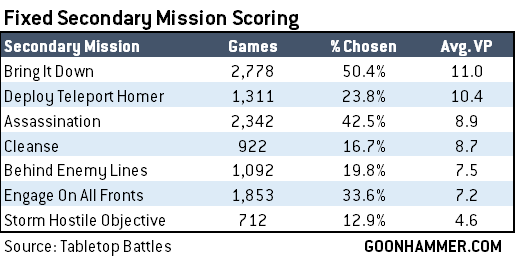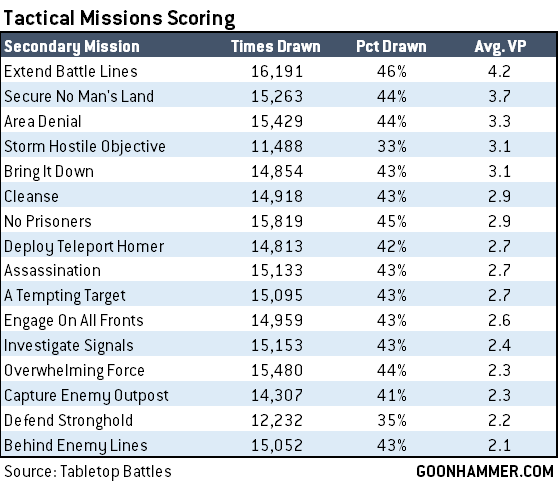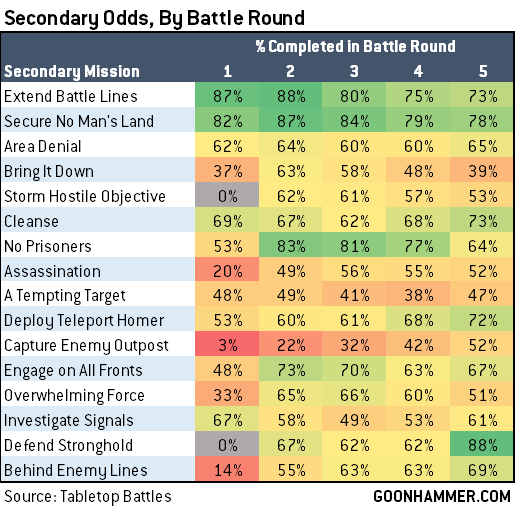Welcome back to Hammer of Math, Dear Reader. Last time around I Looked at primary scoring and promised I’d be back “relatively soon” to talk about Secondary scoring and “soon” has become “now.”
The data in this week’s sample comes from data collected in Tabletop Battles, Goonhammer’s app for tracking games of Warhammer 40k (and now AoS!). If you haven’t downloaded it yet, I’d strongly recommend you give it a look – it’s just the best way to play 40k. For this sample we’re using data from 18,790 games played using the Leviathan GT pack recorded in the Tabletop Battles app since the pack’s release. In this article, we’ll be focusing on secondary missions and scoring.
Tactical vs. Fixed Missions
Let’s start with the most basic question around secondary objectives. Before each game, players can choose whether to play with fixed or tactical objectives. Currently, Tactical Objectives are by far the more popular choice – players selected Fixed missions in just 29.3% of the time. Of these, Bring it Down is the most popular, and incidentally worth the most points on average.
Behind Bring it Down, Assassination is the second most popular, but Deploy Teleport Homer comes second on scoring.
On the whole, Fixed secondary players tend to score worse and perform worse than tactical – on average players choosing Fixed missions score just under 2 points per game less than players on Tactical missions, and this translates to an overall win rate of 46% for Fixed missions players vs. 48.3% for Tactical (note that ties are not counted as wins in our stats).
As you might expect, Tactical Secondaries vary in average value – they aren’t all scored – and typically range from 2 to 4 VP in value. Two are drawn less often – Storm Hostile Objective and Defend Stronghold can’t be drawn turn 1 – and Extend Battle Lines is the clear highest scorer. But that’s not really the whole story – because while your chances of drawing a given secondary about the same, your chances of actually scoring any given secondary are not. So let’s reframe around that, and look at the odds of scoring a given secondary.
Some of this is pretty straightforward: Extend Battle Lines has the highest average score because it’s one of the secondaries you’re most likely to score – practically free in most games, and likewise for Secure No Man’s Land. Likewise, No Prisoners and Cleanse are pretty easy to score, though they’ll frequently be scored at their lower values, keeping them from being too many free VP – though this will vary by army.
This then begs the question: Do these odds change during the course of a game?
So here we can see that Extend Battle Lines and Secure No Man’s Land basically stay sure things throughout the game – these, along with Investigate Signals and Cleanse – are the secondary missions you want to draw turn 1, if possible. No Prisoners is worse on the first battle round, when your targets are far away and may be out of sight, particularly if you went first, and likewise Engage on All Fronts, Assassination, Overwhelming Force, and Bring it Down all improve dramatically after round 1 is over, and may even dip at the end of the game as targets become less plentiful and your forces are depleted.
Capture Enemy Outpost becomes more likely as the game goes on but only barely cracks 50% on the final round, and even then is likely only possible if you’re already in a winning position. Though in a close game, that can make for a huge swing versus drawing it basically as a dead card, turn 1. And likewise, Defend Stronghold becomes much more certain in Round 5, though for less VP.
So knowing this, does it make sense to hold objectives more often, or should we be discarding them?
Knowing When to Hold ‘Em
Let’s start off with a quick definition: A Deferred Secondary is one which you score in a round later than the one in which it was drawn. If I draw something turn 1 and score it two turns later? That’s a Deferred Secondary. Ok, got that? Great. Now let’s look at a stat:
If you’re reading this correctly, it suggests that players are generally much, much better off holding on to secondaries they think they can score than getting new, random cards. That’s only partly intuitive – while discarded secondaries are lost, they do give a CP bonus, and this only holds if the value of an average secondary is lower than the value of a known one.
On that note, let’s talk about that math: First, the average value of a card, in VP, is about 3 (see the above chart), and the average completion percentage for secondaries overall is 67%. That means that on the whole the expected value of a random card is about 2 VP. So if a card in your hand has an EV higher than 2, it’s more valuable than a random replacement. If we take an alternative approach and look at same-turn scoring, we find that 58% of secondaries are scored the turn they are drawn, for an average of 4.33 VP. This gives us an expected value of 2.5, slightly more but similar. So a churn-and-burn strategy will typically generate 10 secondaries per game, averaging 2.5 per, and should expect to score about 14.5 VP. That’s a very beatable secondary score, and not one players would generally be happy with, though it will look better in wins and worse in losses.
What this all suggests is that most players don’t hold on to secondary objectives often enough when they should, and that holding on to secondaries will often be better than generating a new, random secondary – but only when the expected value of a card in your hand is greater than about 2.5 VP. And it’s worth noting this compounds – if you hold an objective for two turns, then you’re essentially giving up 5 VP of value, since you have a chance to score the next objective and its replacement, or just one of the two. And it’s all but impossible for one card to be worth holding through three potential replacements.
So ultimately, you want to hold secondaries you can score on the next turn, but you don’t want to hold them past that – and you don’t want to hold them if you think your odds of scoring them are worse than 50%. Don’t get caught up in the sunken costs fallacy here – hold secondaries for a turn if you know you can make them work – especially on turn 1 – but don’t be afraid to jettison them if they don’t pan out.
Final Thoughts
I was legitimately surprised to find that holding more secondaries tends to lead to more points; I had assumed that it was worth churning through more of your deck most games, and it’s worth potentially looking at sequencing in the future, since sometimes it’ll make more sense to go for long shot secondaries you know are still in there, or to avoid drawing something you know you can’t score.
I’ll be back next week with a look at go first win rates, how they vary by mission, and how the picture isn’t particularly great. As always, if you have any questions or feedback, drop us a note in the comments below or email us at contact@goonhammer.com.







